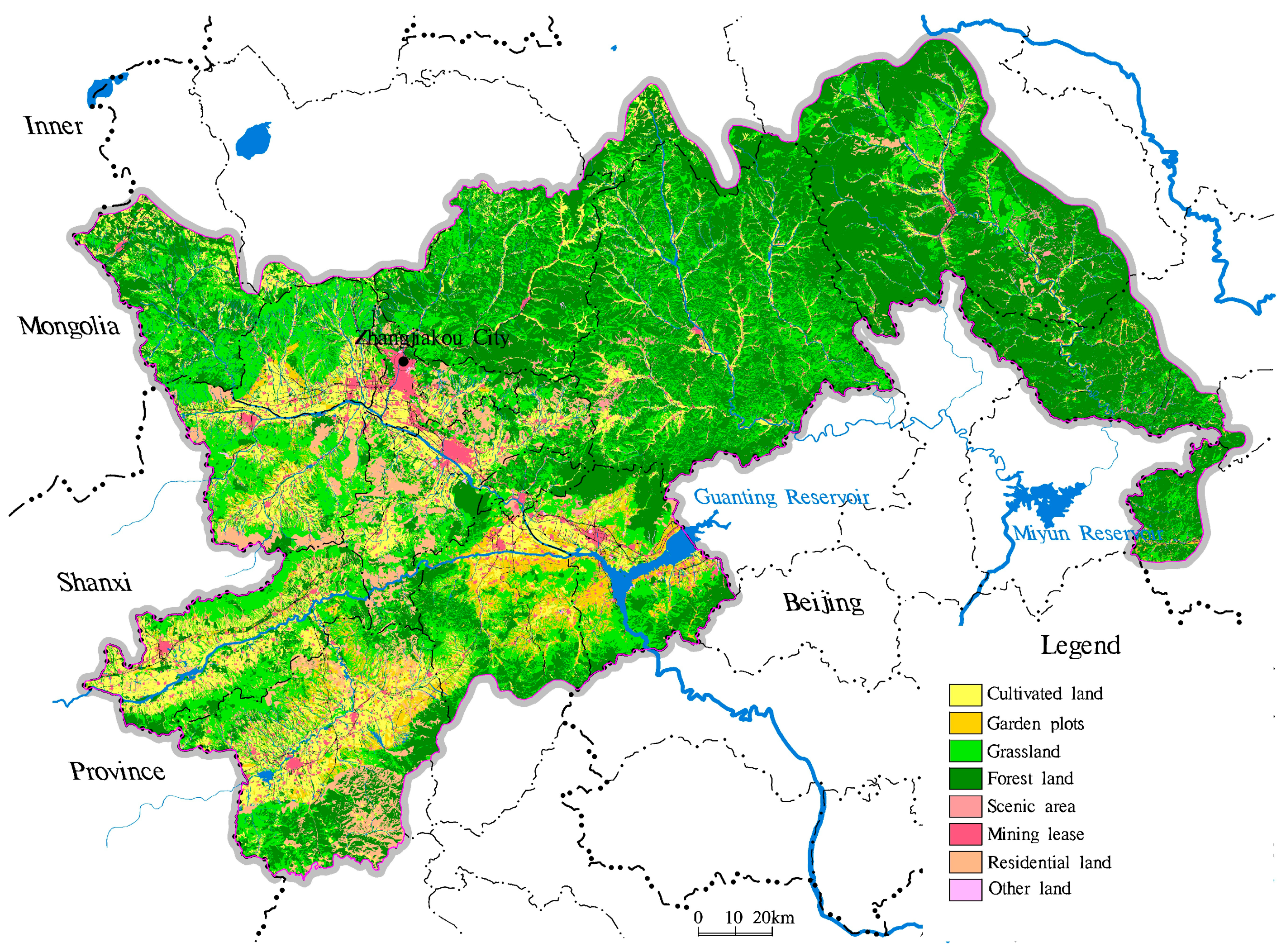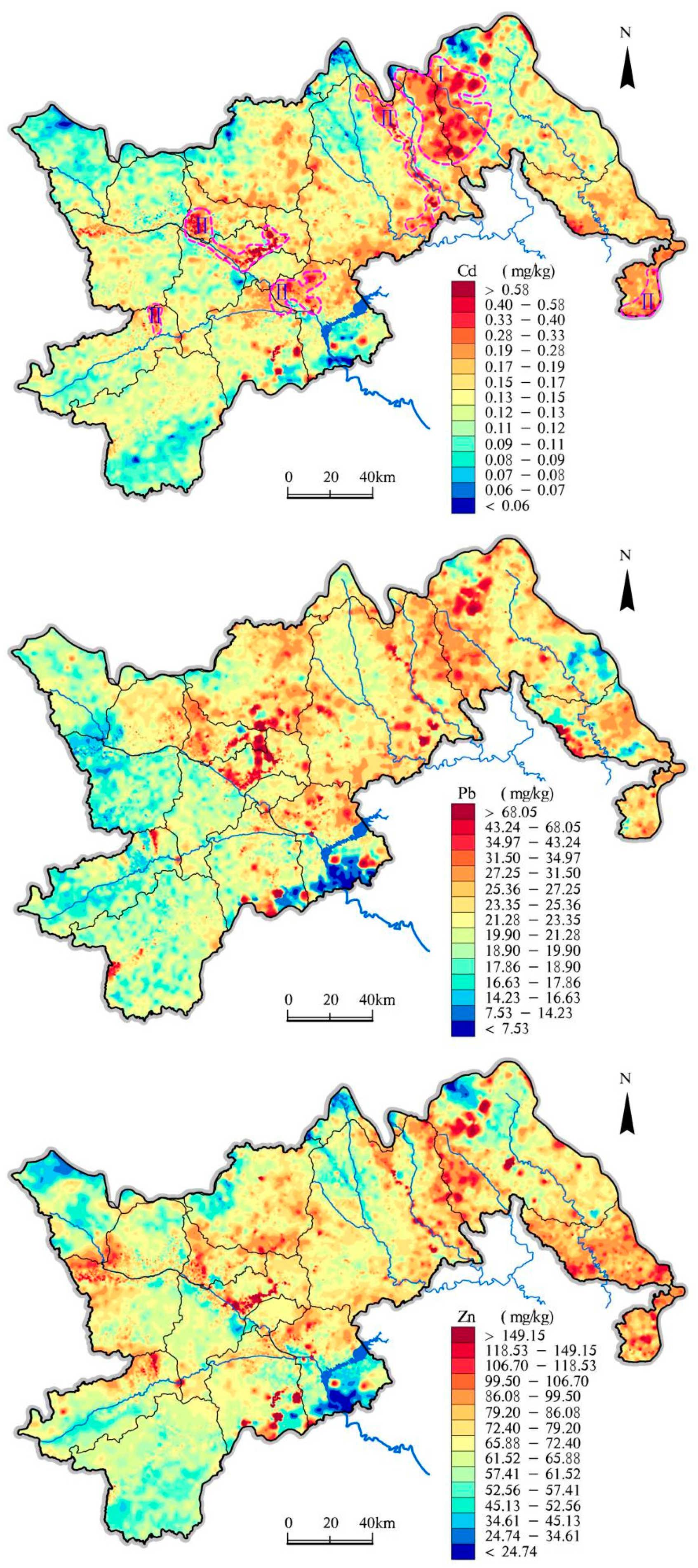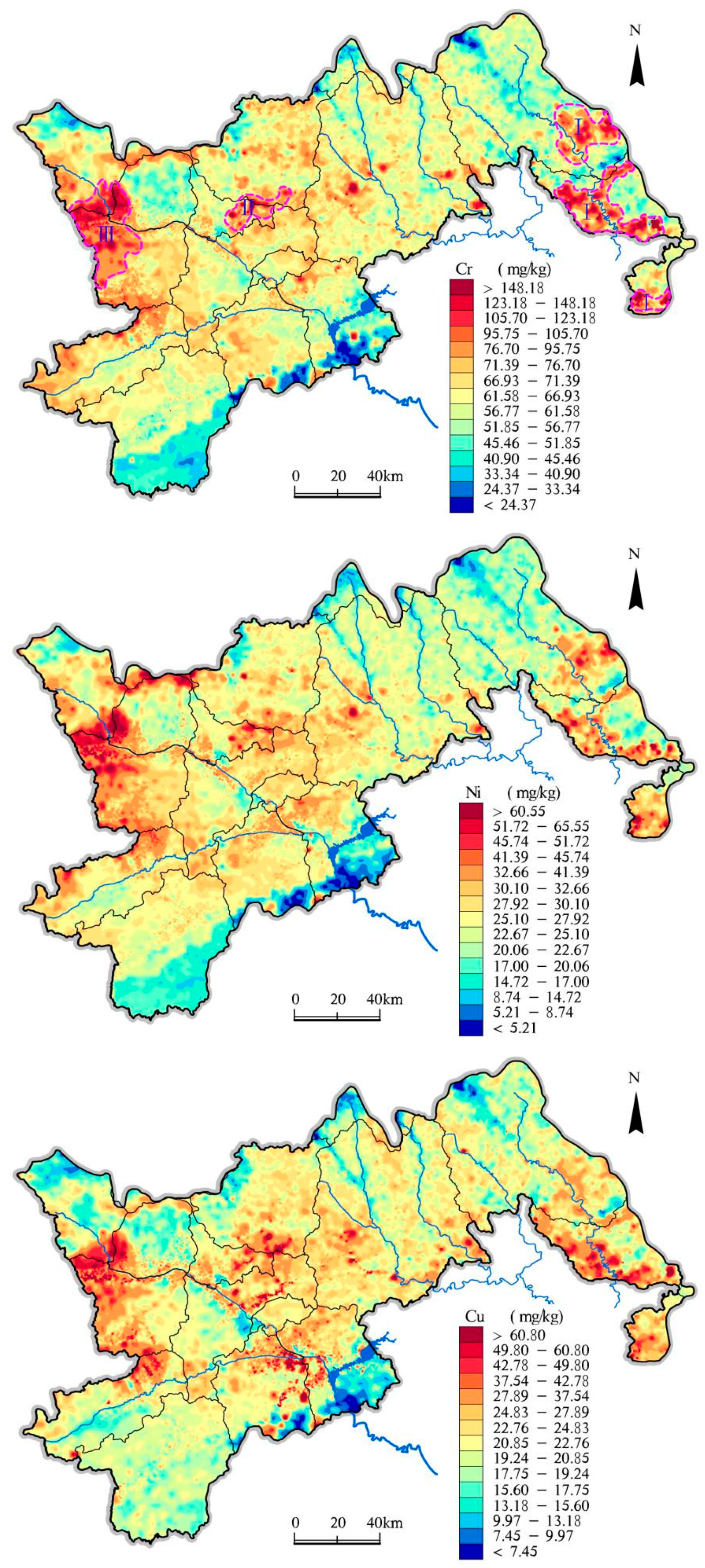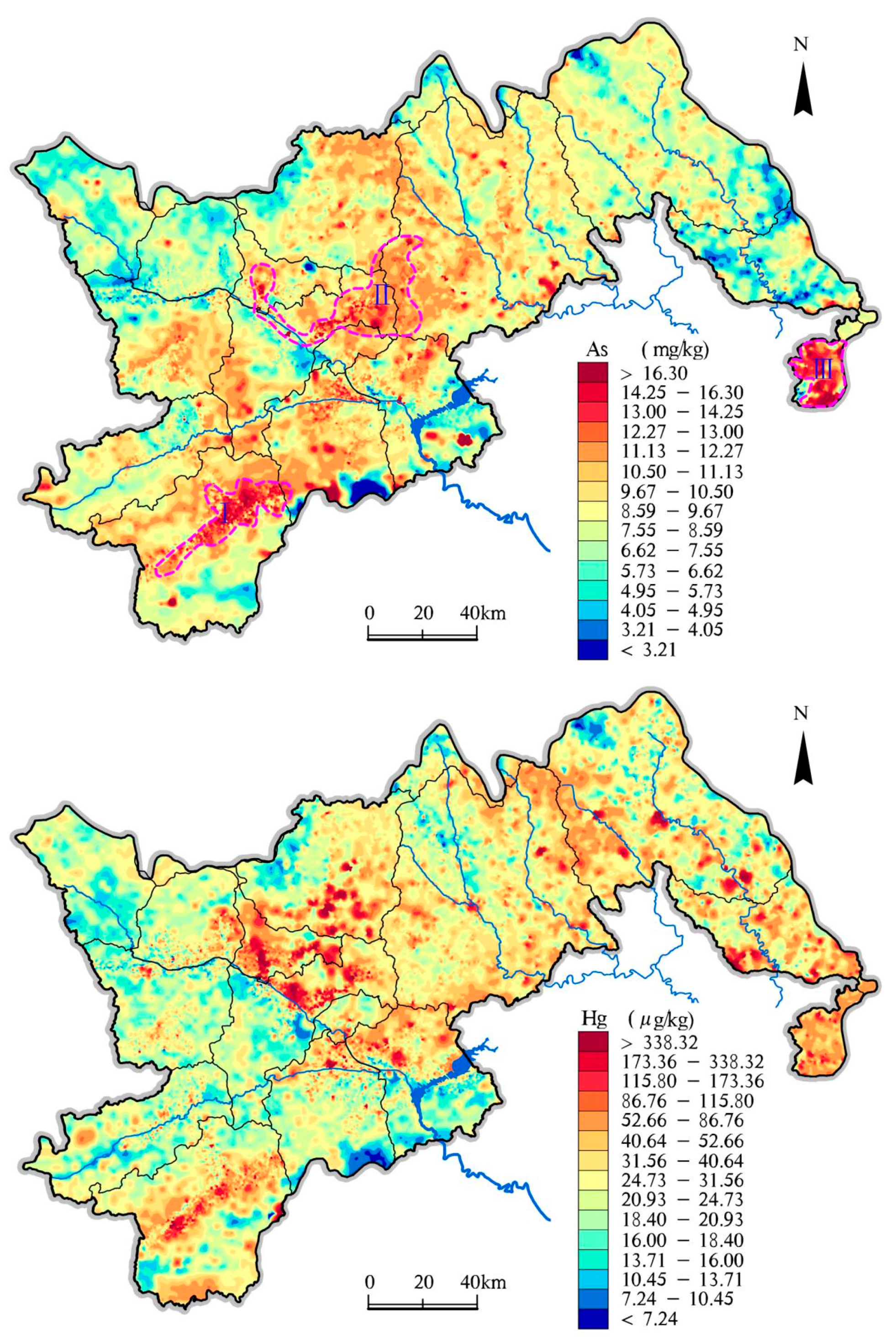The Levels, Sources, and Spatial Distribution of Heavy Metals in Soils from the Drinking Water Sources of Beijing, China
Abstract
1. Introduction
2. Materials and Methods
2.1. Study Area and Sampling Design
2.2. Chemical Analyses
2.3. Statistical Analyses
3. Results and Discussion
3.1. Degree of Heavy Metal Accumulation
3.2. Identification of the Heavy Metal Sources
3.3. Spatial Distributions
4. Conclusions
Author Contributions
Funding
Institutional Review Board Statement
Informed Consent Statement
Data Availability Statement
Acknowledgments
Conflicts of Interest
Abbreviations
References
- Chen, X.; Chen, X.; Wang, Y.; Wang, X.; Wang, M.; Liang, Y.; Zhu, G.; Jin, T. A nomogram for predicting the renal dysfunction in a Chinese population with reduction in cadmium exposure based on an 8 years follow up study. Ecotoxicol. Environ. Saf. 2020, 191, 110251. [Google Scholar] [CrossRef]
- Huang, J.; Peng, S.; Mao, X.; Li, F.; Guo, S.; Shi, L.; Shi, Y.; Yu, H.; Zeng, G. Source apportionment and spatial and quantitative ecological risk assessment of heavy metals in soils from a typical Chinese agricultural county. Process Saf. Environ. Prot. 2019, 126, 339–347. [Google Scholar] [CrossRef]
- Wang, Y.; Duan, X.; Wang, L. Spatial distribution and source analysis of heavy metals in soils influenced by industrial enterprise distribution: Case study in Jiangsu Province. Sci. Total Environ. 2020, 710, 134953. [Google Scholar] [CrossRef]
- Eze, P.N.; Udeigwe, T.K.; Stietiya, M.H. Distribution and potential source evaluation of heavy metals in prominent soils of Accra Plains, Ghana. Geoderma 2010, 156, 357–362. [Google Scholar] [CrossRef]
- Guo, G.; Wu, F.; Xie, F.; Zhang, R. Spatial distribution and pollution assessment of heavy metals in urban soils from southwest China. J. Environ. Sci. 2012, 24, 410–418. [Google Scholar] [CrossRef]
- Solgi, E.; Esmaili-Sari, A.; Riyahi-Bakhtiari, A.; Hadipour, M. Soil contamination of metals in the three industrial Estates, Arak, Iran. Bull. Environ. Contam. Toxicol. 2012, 88, 634–638. [Google Scholar] [CrossRef] [PubMed]
- Dudka, S.; Piotrowska, M.; Chlopecka, A.; Witek, T. Trace metal contamination of soils and crop plants by the mining and smelting industry in Upper Silesia, South Poland. J. Geochem. Explor. 1995, 52, 237–250. [Google Scholar] [CrossRef]
- Khosravi, Y.; Zamani, A.A.; Parizanganeh, A.H.; Yaftian, M.R. Assessment of spatial distribution pattern of heavy metals surrounding a lead and zinc production plant in Zanjan Province, Iran. Geoderma Reg 2018, 12, 10–17. [Google Scholar] [CrossRef]
- Li, S.; Zhao, B.; Jin, M.; Hu, L.; Zhong, H.; He, Z. A comprehensive survey on the horizontal and vertical distribution of heavy metals and microorganisms in soils of a Pb/Zn smelter. J. Hazard. Mater. 2020, 400, 123255. [Google Scholar] [CrossRef]
- Li, X.; Yang, H.; Zhang, C.; Zeng, G.; Liu, Y.; Xu, W.; Wu, Y.; Lan, S. Spatial distribution and transport characteristics of heavy metals around an antimony mine area in central China. Chemosphere 2017, 170, 17–24. [Google Scholar] [CrossRef] [PubMed]
- Loska, K.; Wiechuła, D.; Korus, I. Metal contamination of farming soils affected by industry. Environ. Int. 2004, 30, 159–165. [Google Scholar] [CrossRef]
- Srinivasa Gowd, S.; Ramakrishna Reddy, M.; Govil, P.K. Assessment of heavy metal contamination in soils at Jajmau (Kanpur) and Unnao industrial areas of the Ganga Plain, Uttar Pradesh, India. J. Hazard. Mater. 2010, 174, 113–121. [Google Scholar] [CrossRef] [PubMed]
- Cai, L.M.; Wang, Q.S.; Wen, H.H.; Luo, J.; Wang, S. Heavy metals in agricultural soils from a typical township in Guangdong Province, China: Occurrences and spatial distribution. Ecotoxicol. Environ. Saf. 2019, 168, 184–191. [Google Scholar] [CrossRef]
- Morton-Bermea, O.; Hernández-Álvarez, E.; González-Hernández, G.; Romero, F.; Lozano, R.; Beramendi-Orosco, L.E. Assessment of heavy metal pollution in urban topsoils from the metropolitan area of Mexico City. J. Geochem. Explor. 2009, 101, 218–224. [Google Scholar] [CrossRef]
- Pan, L.B.; Ma, J.; Wang, X.L.; Hou, H. Heavy metals in soils from a typical county in Shanxi Province, China: Levels, sources and spatial distribution. Chemosphere 2016, 148, 248–254. [Google Scholar] [CrossRef]
- Szolnoki, Z.; Farsang, A.; Puskás, I. Cumulative impacts of human activities on urban garden soils: Origin and accumulation of metals. Environ. Pollut. 2013, 177, 106–115. [Google Scholar] [CrossRef]
- Bednářová, Z.; Kalina, J.; Hájek, O.; Sáňka, M.; Komprdová, K. Spatial distribution and risk assessment of metals in agricultural soils. Geoderma 2016, 284, 113–121. [Google Scholar] [CrossRef]
- Dartan, G.; Taşpınar, F.; Toröz, İ. Assessment of heavy metals in agricultural soils and their source apportionment: A Turkish district survey. Environ. Monit. Assess 2015, 187, 99. [Google Scholar] [CrossRef] [PubMed]
- Shao, D.; Zhan, Y.; Zhou, W.; Zhu, L. Current status and temporal trend of heavy metals in farmland soil of the Yangtze River Delta Region: Field survey and meta-analysis. Environ. Pollut. 2016, 219, 329–336. [Google Scholar] [CrossRef] [PubMed]
- Wang, P.; Li, Z.; Liu, J.; Bi, X.; Ning, Y.; Yang, S.; Yang, X. Apportionment of sources of heavy metals to agricultural soils using isotope fingerprints and multivariate statistical analyses. Environ. Pollut. 2019, 249, 208–216. [Google Scholar] [CrossRef]
- Doyi, I.; Essumang, D.; Gbeddy, G.; Dampare, S.; Kumassah, E.; Saka, D. Spatial distribution, accumulation and human health risk assessment of heavy metals in soil and groundwater of the Tano Basin, Ghana. Ecotoxicol. Environ. Saf. 2018, 165, 540–546. [Google Scholar] [CrossRef] [PubMed]
- Wu, W.; Qu, S.; Nel, W.; Ji, J. The impact of natural weathering and mining on heavy metal accumulation in the karst areas of the Pearl River Basin, China. Sci. Total Environ 2020, 734, 139480. [Google Scholar] [CrossRef] [PubMed]
- Zhang, H.; Zeng, H.; Jiang, Y.; Xie, Z.; Xu, X.; Ding, M.; Wang, P. Using the compound system to synthetically evaluate the enrichment of heavy metal(loid)s in a subtropical basin, China. Environ. Pollut. 2020, 256, 113396. [Google Scholar] [CrossRef] [PubMed]
- Facchinelli, A.; Sacchi, E.; Mallen, L. Multivariate statistical and GIS-based approach to identify heavy metal sources in soils. Environ. Pollut. 2001, 114, 313–324. [Google Scholar] [CrossRef]
- Wang, S.; Cai, L.M.; Wen, H.H.; Luo, J.; Wang, Q.S.; Liu, X. Spatial distribution and source apportionment of heavy metals in soil from a typical county-level city of Guangdong Province, China. Sci. Total Environ. 2019, 655, 92–101. [Google Scholar] [CrossRef]
- Sun, L.; Guo, D.; Liu, K.; Meng, H.; Zheng, Y.; Yuan, F.; Zhu, G. Levels, sources, and spatial distribution of heavy metals in soils from a typical coal industrial city of Tangshan, China. Catena 2019, 175, 101–109. [Google Scholar] [CrossRef]
- Marrugo-Negrete, J.; Pinedo-Hernández, J.; Díez, S. Assessment of heavy metal pollution, spatial distribution and origin in agricultural soils along the Sinú River Basin, Colombia. Environ. Res. 2017, 154, 380–388. [Google Scholar] [CrossRef]
- Cai, L.; Xu, Z.; Ren, M.; Guo, Q.; Hu, X.; Hu, G.; Wan, H.; Peng, P. Source identification of eight hazardous heavy metals in agricultural soils of Huizhou, Guangdong Province, China. Ecotoxicol. Environ. Saf. 2012, 78, 2–8. [Google Scholar] [CrossRef] [PubMed]
- Franco-Uría, A.; López-Mateo, C.; Roca, E.; Fernández-Marcos, M.L. Source identification of heavy metals in pastureland by multivariate analysis in NW Spain. J. Hazard. Mater. 2009, 165, 1008–1015. [Google Scholar] [CrossRef]
- Lv, J.; Liu, Y.; Zhang, Z.; Dai, J.; Dai, B.; Zhu, Y. Identifying the origins and spatial distributions of heavy metals in soils of Ju country (Eastern China) using multivariate and geostatistical approach. J. Soils Sediments 2015, 15, 163–178. [Google Scholar] [CrossRef]
- Nanos, N.; Rodríguez Martín, J.A. Multiscale analysis of heavy metal contents in soils: Spatial variability in the Duero river basin (Spain). Geoderma 2012, 89–90, 554–562. [Google Scholar] [CrossRef]
- Rodríguez, J.A.; Nanos, N.; Grau, J.M.; Gil, L.; López-Arias, M. Multiscale analysis of heavy metal contents in Spanish agricultural topsoils. Chemosphere 2008, 70, 1085–1096. [Google Scholar] [CrossRef] [PubMed]
- Stefanowicz, A.M.; Woch, M.W.; Kapusta, P. Inconspicuous waste heaps left by historical Zn–Pb mining are hot spots of soil contamination. Geoderma 2014, 235–236, 1–8. [Google Scholar] [CrossRef]
- Sun, C.; Liu, J.; Wang, Y.; Sun, L.; Yu, H. Multivariate and geostatistical analyses of the spatial distribution and sources of heavy metals in agricultural soil in Dehui, Northeast China. Chemosphere 2013, 92, 517–523. [Google Scholar] [CrossRef]
- Lu, A.; Wang, J.; Qin, X.; Wang, K.; Han, P.; Zhang, S. Multivariate and geostatistical analyses of the spatial distribution and origin of heavy metals in the agricultural soils in Shunyi, Beijing, China. Sci. Total Environ. 2012, 425, 66–74. [Google Scholar] [CrossRef]
- Ouyang, W.; Wang, Y.; Lin, C.; He, M.; Hao, F.; Liu, H.; Zhu, W. Heavy metal loss from agricultural watershed to aquatic system: A scientometrics review. Sci. Total Environ. 2018, 637–638, 208–220. [Google Scholar] [CrossRef] [PubMed]
- Rey, J.; Martínez, J.; Hidalgo, M.C.; Rojas, D. Heavy metal pollution in the Quaternary Garza basin: A multidisciplinary study of the environmental risks posed by mining (Linares, southern Spain). Catena 2013, 110, 234–242. [Google Scholar] [CrossRef]





| Maximum | Minimum | Median | Mean | SD | CV | Background Concentrations | |
|---|---|---|---|---|---|---|---|
| Zn | 2700.00 | 7.69 | 67.70 | 72.08 | 35.53 | 0.49 | 78.4 |
| Cr | 1258.00 | 7.50 | 62.80 | 65.04 | 17.97 | 0.28 | 68.3 |
| Pb | 999.00 | 2.40 | 22.00 | 23.37 | 13.54 | 0.58 | 21.5 |
| Ni | 177.00 | 3.00 | 27.50 | 28.05 | 7.91 | 0.28 | 30.8 |
| Cu | 354.00 | 2.29 | 22.50 | 25.06 | 11.20 | 0.45 | 21.8 |
| Cd | 6.89 | 0.04 | 0.14 | 0.16 | 0.13 | 0.82 | 0.094 |
| Hg | 4.430 | 0.003 | 0.028 | 0.046 | 0.093 | 2.03 | 0.036 |
| As | 148.00 | 0.35 | 9.53 | 9.40 | 2.91 | 0.31 | 13.6 |
| pH | 10.27 | 4.66 | 8.44 | 8.29 | 0.59 | 0.07 | -- |
| Component | Initial eigENVALUEs | Extraction Sums of Squared Loadings | Rotation Sums of Squared Loadings | ||||||
|---|---|---|---|---|---|---|---|---|---|
| Total | % of Variance | Cumulative% | Total | % of Variance | Cumulative% | Total | % of Variance | Cumulative% | |
| 1 | 2.905 | 36.309 | 36.309 | 2.905 | 36.309 | 36.309 | 2.375 | 29.692 | 29.692 |
| 2 | 1.769 | 22.112 | 58.421 | 1.769 | 22.112 | 58.421 | 2.298 | 28.730 | 58.421 |
| 3 | 0.975 | 12.188 | 70.609 | 0.975 | 12.188 | 70.609 | 1.229 | 15.361 | 70.609 |
| 4 | 0.866 | 10.824 | 81.433 | ||||||
| 5 | 0.695 | 8.683 | 90.117 | ||||||
| 6 | 0.407 | 5.091 | 95.208 | ||||||
| 7 | 0.243 | 3.034 | 98.242 | ||||||
| 8 | 0.141 | 1.758 | 100.000 | ||||||
| Rock Mass | Cd | Pb | Zn | Cu |
|---|---|---|---|---|
| Chicheng Baicai quartz syenite porphyry | 0.140 | 79.86 | 168.59 | 8.68 |
| Chicheng Sandaogou granite | 0.053 | 16.70 | 52.37 | 6.73 |
| Fengning Nanhou granite | 0.034 | 18.40 | 38.26 | 5.32 |
| Fengning Laohugou granite | 0.058 | 17.16 | 30.90 | 5.43 |
| Fengning Heishanzui monzonite porphyry | 0.087 | 31.76 | 78.13 | 5.24 |
| Fengning Pingdingshan granite | 0.037 | 22.85 | 48.99 | 9.05 |
| Chicheng Bingshanliang monzonite granite | 0.042 | 23.30 | 18.33 | 6.67 |
| Fengning Jizhazi granite | 0.031 | 20.85 | 32.25 | 5.69 |
| Fengning Shangyingzi granite | 0.037 | 23.32 | 33.91 | 9.37 |
| Elements | As | Cd | Cr | Cu | Hg | Ni | Pb | Zn |
|---|---|---|---|---|---|---|---|---|
| Mean element content value of the near-surface dust | 9.55 | 1.32 | 172.54 | 56.96 | 0.096 | 41.89 | 99.63 | 729.37 |
| Mean element content value of the soil | 9.79 | 0.27 | 69 | 37.44 | 0.091 | 32.01 | 36.75 | 141.94 |
| Ratio | 0.98 | 4.89 | 2.50 | 1.52 | 1.05 | 1.31 | 2.71 | 5.14 |
Publisher’s Note: MDPI stays neutral with regard to jurisdictional claims in published maps and institutional affiliations. |
© 2021 by the authors. Licensee MDPI, Basel, Switzerland. This article is an open access article distributed under the terms and conditions of the Creative Commons Attribution (CC BY) license (http://creativecommons.org/licenses/by/4.0/).
Share and Cite
Wei, J.; Zheng, X.; Liu, J.; Zhang, G.; Zhang, Y.; Wang, C.; Liu, Y. The Levels, Sources, and Spatial Distribution of Heavy Metals in Soils from the Drinking Water Sources of Beijing, China. Sustainability 2021, 13, 3719. https://doi.org/10.3390/su13073719
Wei J, Zheng X, Liu J, Zhang G, Zhang Y, Wang C, Liu Y. The Levels, Sources, and Spatial Distribution of Heavy Metals in Soils from the Drinking Water Sources of Beijing, China. Sustainability. 2021; 13(7):3719. https://doi.org/10.3390/su13073719
Chicago/Turabian StyleWei, Jing, Xiaogang Zheng, Jintong Liu, Guowei Zhang, Yanxi Zhang, Cailing Wang, and Yuanchen Liu. 2021. "The Levels, Sources, and Spatial Distribution of Heavy Metals in Soils from the Drinking Water Sources of Beijing, China" Sustainability 13, no. 7: 3719. https://doi.org/10.3390/su13073719
APA StyleWei, J., Zheng, X., Liu, J., Zhang, G., Zhang, Y., Wang, C., & Liu, Y. (2021). The Levels, Sources, and Spatial Distribution of Heavy Metals in Soils from the Drinking Water Sources of Beijing, China. Sustainability, 13(7), 3719. https://doi.org/10.3390/su13073719





